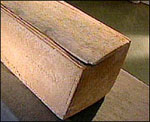 |
| An
empty ossuary, or limestone burial box for bones is seen with
an inscription in Aramaic reading ' ``James, son of Joseph,
brother of Jesus.'' |
An inscription on a burial artifact that was recently discovered
in Israel appears to provide the oldest archaeological evidence
of Jesus Christ, according to an expert who dates it to three
decades after the rucifixion.
Writing in Biblical Archaeology Review, Andre Lemaire, a specialist
in ancient inscriptions, says it is very probable the find is
an authentic reference to Jesus of Nazareth.
That Jesus existed is not doubted by scholars, but what the world
knows about him comes almost entirely from the New Testament.
No physical artifact from the first century related to Jesus has
been discovered and verified. Lemaire believes that has changed,
though questions remain, such as where the piece with the inscription
has been for more than 19 centuries.
The inscription, in the Aramaic language, appears on an empty
ossuary, or limestone burial box for bones. It reads: "James,
son of Joseph, brother of Jesus." Lemaire dates the object
to 63 A.D.
Lemaire says the writing style, and the fact that Jews practiced
ossuary burials only between 20 B.C. and A.D. 70, puts the inscription
squarely in the time of Jesus and James, who led the early church
in Jerusalem.
All three names were commonplace, but he estimates that only
20 Jameses in Jerusalem during that era would have had a father
named Joseph and a brother named Jesus.
Moreover, naming the brother as well as the father on an ossuary
was "very unusual," Lemaire says. There's only one other
known example in Aramaic. Thus, this particular Jesus must have
had some unusual role or fame - and Jesus of Nazareth certainly
qualified, Lemaire concludes.
It's impossible, however, to prove absolutely that the Jesus
named on the box was Jesus of Nazareth.
(Agencies)
